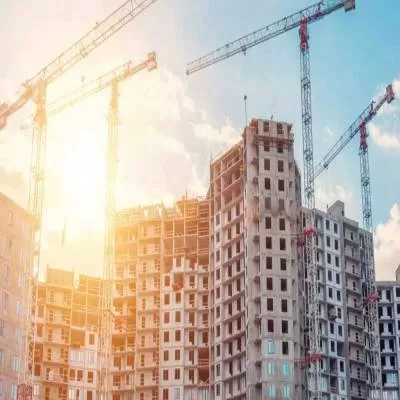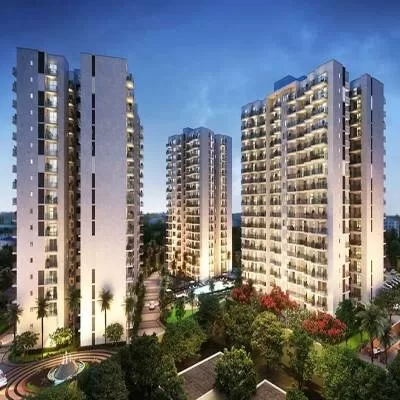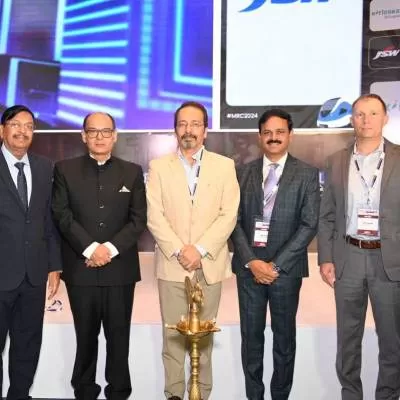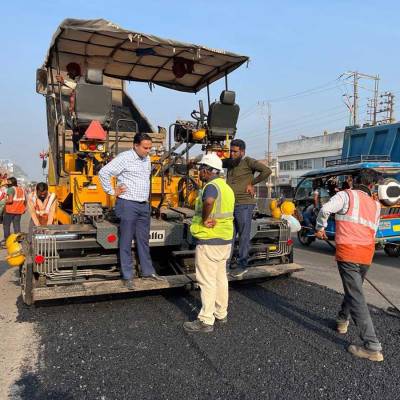- Home
- Real Estate
- Women are born multi-taskers; we can do anything
Women are born multi-taskers; we can do anything
When she believed she could, she was already halfway there. Over eight years ago, Ujjwala Satish Haware had a different story to narrate. Born and brought up in Amravati near Nagpur, she decided to be an architect early as when she was in the seventh grade. And in 1997, she secured her Bachelors of Architecture degree from Amravati University. After marriage, she joined her husband Satish Haware's company in Mumbai, Haware Engineers & Builders, as a director.
However, in 2005, she lost her husband. "I knew what he dreamt for this company and to see all of it just vanish with him was not acceptable," she says. So she stepped forward and took over the reins of the company as chairperson. Today, the company is thriving under her leadership. Moreover, Haware is an executive committee member of the Builders' Association of Navi Mumbai and member, MCHI, Mumbai. Unassuming and candid, she shares her experiences and perspective in conversation with SHRIYAL SETHUMADHAVAN.
What were the challenges you faced when you took over as chairperson?
The thought of taking the company forward without my husband was a task in itself. Then, some JV partners showed their true colours; they went to the extent of filing criminal cases. But my staff always supported me, I took good legal advice and everything got settled. Also, the staff had lost all focus without my husband. I decided to go back for them and all our customers who had booked houses and were relying on us.
Did you face a gender bias?
Yes. But then women are always soft targets.
Did you have a mentor or support system?
My only support system has been my family. They held me strong in bad times. I also had the support of many staff members. And many of my husband's friends - with a strong political background - stood by us.
What are your current responsibilities?
I look at overall operations. Apart from the design aspects, where my core interests lie, I look into accounts, loans, customer service, material purchase, brand building, etc. And as I also visit sites, I control a bit of the engineering part as well.
You have provided homes to over 45,000 people and have 15 ongoing projects in Mumbai, Navi Mumbai and Thane. What are your strategies to keep these figures ticking?
The company's basic concept was to provide houses for all. But we realised that there were a lot of avenues for the rich; it was mainly the middle class and lower middle class who could not afford high end houses. Although we construct premium houses, malls and IT parks, we realise that these people are the actual users, and with such a target audience, the market can rarely be down.
How are places like Thane and Navi Mumbai growing as real-estate propositions?
Thane is growing very well with immense scope of development on the Ghodbunder road. However, it is not a well-planned city like Navi Mumbai. Every developer is planning according to whatever land he has.
How about your activities in Mumbai?
In Mumbai, we have mostly done redevelopment projects for MHADA. But the process is very slow. You require several permissions and the authority itself is not very clear about existing policies. Also, MHADA and BMC have their own differences.
Does the real estate regulatory bill look like a good solution?
Transparency is the key. We are bulk producers and do not aim to do just one building with a few loopholes and then disappear. We want everything to be clear without any corruption. This will benefit us as well as customers.
But are the rules also equally transparent; for instance, the requirements for environment clearance?
If a corporation says that a 9 m road is sufficient within a project or big layout, the environment department will not approve saying that it seems to be a small route. We need an expert to chalk out what in the true sense is environment. Now again, there is a vague rule that you require environment clearance only for 200,000 sq ft of land and above.
If the environment is a concern, clearance should be applicable for all, whatever the size of the land.
With this rule, are developers adopting any kind of strategies for land clearence?
This is what is happening now. If I have 30 acre, I will make parts of it so that I can skip the clearance. Although I am environmentally aware, there are many ways to bypass such laws. The environment is certainly important to us. We use corporation water only for drinking and domestic use. Then, we create a bore well and that water is used for flushing and other purposes. So, if this rule prevails, I will certainly avoid the environment clearance. But I will obey all the rules of rainwater harvesting, planting trees, installing solar, etc. My only aim is to bypass that seven to eight month period, which at times goes up to a year, for clearance, which escalates costs for the builder and customer. So the government should actually have more clarity in the development control rules (DCRs).
Over the past year, in Mumbai particularly, the market has been a little sluggish. How has this affected your operations?
It has led to an increase in land cost and raw material prices. With increase in rates, properties have also gone beyond the common man's reach. We provide the most affordable houses, yet people wait for the rates to go down. So sales are affected. DCRs should be builder and customer-friendly. This year, they will finalise one set of rules and then, next year, someone else will come along and make changes. This is what gets confusing.
Tell us about your nano housing scheme.
It is actually my husband's concept. He designed small houses by reducing their size by 25 per cent. So a 1 BHK of 650 sq ft is made as 450 sq ft while the amenities remain the same. But naturally, the construction and sales costs reduce by 25 per cent each, and the total reduction is nearly 40-50 per cent, making it affordable.
You have also designed about 200 houses for those without a salary slip...
The project, Shramik, that we executed in Kharghar in 2003 was my husband's dream. It was designed for people like auto drivers, hawkers, maidservants, etc, under the nano housing scheme; each house was rated at Rs 200,000. As the banks did not sanction their loans, we gave them loans from our housing finance company. Today, all the loans have been repaid.
How do you see the future for the company?
In the next five years, I may construct 60,000 or 70,000 additional houses. I also have a land bank of 300-350 acre which will hold on for at least the next 10 years.
What is your message to woman within this industry?
All that a woman requires is courage. At times we feel uncomfortable to talk to contractors, suppliers, etc. But we have the power to adjust and do anything. We are born multi-taskers.
Ujjwala Satish Haware, Chairperson, Haware Engineers & Builders When she believed she could, she was already halfway there. Over eight years ago, Ujjwala Satish Haware had a different story to narrate. Born and brought up in Amravati near Nagpur, she decided to be an architect early as when she was in the seventh grade. And in 1997, she secured her Bachelors of Architecture degree from Amravati University. After marriage, she joined her husband Satish Haware's company in Mumbai, Haware Engineers & Builders, as a director. However, in 2005, she lost her husband. "I knew what he dreamt for this company and to see all of it just vanish with him was not acceptable," she says. So she stepped forward and took over the reins of the company as chairperson. Today, the company is thriving under her leadership. Moreover, Haware is an executive committee member of the Builders' Association of Navi Mumbai and member, MCHI, Mumbai. Unassuming and candid, she shares her experiences and perspective in conversation with SHRIYAL SETHUMADHAVAN. What were the challenges you faced when you took over as chairperson? The thought of taking the company forward without my husband was a task in itself. Then, some JV partners showed their true colours; they went to the extent of filing criminal cases. But my staff always supported me, I took good legal advice and everything got settled. Also, the staff had lost all focus without my husband. I decided to go back for them and all our customers who had booked houses and were relying on us. Did you face a gender bias? Yes. But then women are always soft targets. Did you have a mentor or support system? My only support system has been my family. They held me strong in bad times. I also had the support of many staff members. And many of my husband's friends - with a strong political background - stood by us. What are your current responsibilities? I look at overall operations. Apart from the design aspects, where my core interests lie, I look into accounts, loans, customer service, material purchase, brand building, etc. And as I also visit sites, I control a bit of the engineering part as well. You have provided homes to over 45,000 people and have 15 ongoing projects in Mumbai, Navi Mumbai and Thane. What are your strategies to keep these figures ticking? The company's basic concept was to provide houses for all. But we realised that there were a lot of avenues for the rich; it was mainly the middle class and lower middle class who could not afford high end houses. Although we construct premium houses, malls and IT parks, we realise that these people are the actual users, and with such a target audience, the market can rarely be down. How are places like Thane and Navi Mumbai growing as real-estate propositions? Thane is growing very well with immense scope of development on the Ghodbunder road. However, it is not a well-planned city like Navi Mumbai. Every developer is planning according to whatever land he has. How about your activities in Mumbai? In Mumbai, we have mostly done redevelopment projects for MHADA. But the process is very slow. You require several permissions and the authority itself is not very clear about existing policies. Also, MHADA and BMC have their own differences. Does the real estate regulatory bill look like a good solution? Transparency is the key. We are bulk producers and do not aim to do just one building with a few loopholes and then disappear. We want everything to be clear without any corruption. This will benefit us as well as customers. But are the rules also equally transparent; for instance, the requirements for environment clearance? If a corporation says that a 9 m road is sufficient within a project or big layout, the environment department will not approve saying that it seems to be a small route. We need an expert to chalk out what in the true sense is environment. Now again, there is a vague rule that you require environment clearance only for 200,000 sq ft of land and above. If the environment is a concern, clearance should be applicable for all, whatever the size of the land. With this rule, are developers adopting any kind of strategies for land clearence? This is what is happening now. If I have 30 acre, I will make parts of it so that I can skip the clearance. Although I am environmentally aware, there are many ways to bypass such laws. The environment is certainly important to us. We use corporation water only for drinking and domestic use. Then, we create a bore well and that water is used for flushing and other purposes. So, if this rule prevails, I will certainly avoid the environment clearance. But I will obey all the rules of rainwater harvesting, planting trees, installing solar, etc. My only aim is to bypass that seven to eight month period, which at times goes up to a year, for clearance, which escalates costs for the builder and customer. So the government should actually have more clarity in the development control rules (DCRs). Over the past year, in Mumbai particularly, the market has been a little sluggish. How has this affected your operations? It has led to an increase in land cost and raw material prices. With increase in rates, properties have also gone beyond the common man's reach. We provide the most affordable houses, yet people wait for the rates to go down. So sales are affected. DCRs should be builder and customer-friendly. This year, they will finalise one set of rules and then, next year, someone else will come along and make changes. This is what gets confusing. Tell us about your nano housing scheme. It is actually my husband's concept. He designed small houses by reducing their size by 25 per cent. So a 1 BHK of 650 sq ft is made as 450 sq ft while the amenities remain the same. But naturally, the construction and sales costs reduce by 25 per cent each, and the total reduction is nearly 40-50 per cent, making it affordable. You have also designed about 200 houses for those without a salary slip... The project, Shramik, that we executed in Kharghar in 2003 was my husband's dream. It was designed for people like auto drivers, hawkers, maidservants, etc, under the nano housing scheme; each house was rated at Rs 200,000. As the banks did not sanction their loans, we gave them loans from our housing finance company. Today, all the loans have been repaid. How do you see the future for the company? In the next five years, I may construct 60,000 or 70,000 additional houses. I also have a land bank of 300-350 acre which will hold on for at least the next 10 years. What is your message to woman within this industry? All that a woman requires is courage. At times we feel uncomfortable to talk to contractors, suppliers, etc. But we have the power to adjust and do anything. We are born multi-taskers.
























